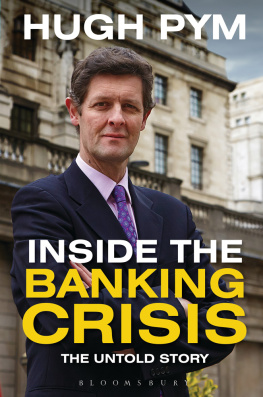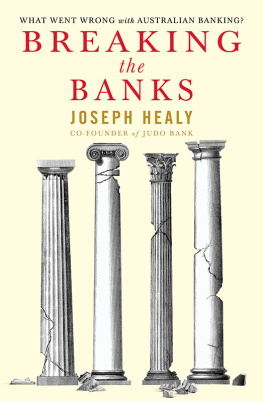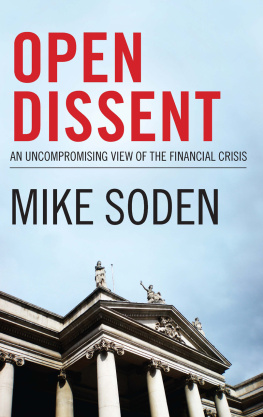Brown, Gordon. Beyond the Crash: Overcoming the First Crisis of Globalization . London: Simon & Schuster, 2010.
Brummer, Alex. The Crunch: How Greed and Incompetence Sparked the Credit Crisis . London: Random House Business Books, 2008.
Cable, Vince. The Storm: The World Economic Crisis and What it Means . London: Atlantic Books, 2009.
Darling, Alistair. Back From the Brink: 1000 Days at Number 11 . London: Atlantic Books, 2011.
Farag, Marc, Damian Harland and Dan Nixon. Bank Capital and Liquidity. Bank of England Quarterly Bulletin, September 2013.
House of Commons Treasury Select Committee. The Run on the Rock: Fifth Report of Sessions 200708 . London: The Stationery Office Limited, 2008.
Martin, Iain. Making it Happen: Fred Goodwin, RBS and the Men Who Blew Up the British Economy . London: Simon & Schuster, 2013.
McBride, Damian. Power Trip: A Decade of Policy, Plots and Spin . London: Biteback Publishing, 2013.
Parliamentary Commission on Banking Standards. An Accident Waiting to Happen: The Failure of HBOS: Fourth Report of Sessions 201213 . London: The Stationery Office Limited, 2013.
Parliamentary Commission on Banking Standards. Changing Banking for Good: First Report of Sessions 201314 . London: The Stationery Office Limited, 2013.
Paulson, Hank. On the Brink: Inside the Race to Stop the Collapse of the Global Financial System . London: Headline Publishing Group, 2010.
Perman, Ray. Hubris: How HBOS Wrecked the Best Bank in Britain . Edinburgh: Birlinn Limited, 2012.
Nothing like it had been seen on Britains streets since the late nineteenth century. Queues outside bank branches were images that most people associated with grainy footage from Germany or the United States in the 1930s. It just wasnt British. But it was on 14 September 2007. First a handful, then a dozen and then a few more began to congregate in streets. They were queuing to get into branches of the Northern Rock bank. They were behaving in a way which was perfectly rational according to the Governor of the Bank of England. With the official deposit protection scheme covering only a proportion of their savings, why take a risk if they had a tidy sum in a bank which needed emergency loans? Rational it might have been, but the episode proved disastrous for the countrys international image and will remain etched in the history books as a shameful chapter. International TV coverage of the Northern Rock queues, according to one horrified MP, made the UK look like Zimbabwe.
There were many causes of the Northern Rock debacle. One of the main reasons was the dramatic reversal in market conditions which took its toll on most banks Northern Rock was among the first to be knocked over. The seizing up of financial markets in August 2007 has been well documented. Put simply, there had been a credit bubble and it had burst. In the early years of the decade, major central banks had lowered interest rates in an attempt to stimulate growth after the internet and technology boom had turned to bust and the Iraq war dented international confidence. Savings and surpluses built up in fast-growing Asian economies needed to find a home. The result was a flood of funds surging around the world markets. Official interest rates were low so the hunt was on for higher returns from more exotic investments. Banks were falling over themselves to lend. The sub-prime mortgage debacle was the result of this credit binge. Low-income US borrowers were targeted and persuaded to sign up for mortgages which they had little chance of repaying. In a constantly rising housing market defaults are not a problem as the lender can easily sell the property. But the crunch comes, as it did in 2007, when house prices start to fall. Borrowers hand in the keys and banks are left with properties worth a lot less than the original loan.
The US sub-prime disaster had such a huge impact on financial markets because exposure to vulnerable American borrowers was so widely spread around the international banking system. US lenders sliced and diced the mortgages and packaged them up as sophisticated instruments with names like collateralised debt obligations and asset-backed securities. They were created, sold and re-sold and ended up on the balance sheets of US, Asian and European banks. When house prices started to fall and defaults rose, the music in this global financial game stopped. Suddenly everyone wanted out. They scrambled to cut their losses on the sub-prime mortgages. But they were selling into a falling market. Valuations of the assets became impossible. And as every bank began to take stock of its own problems, the next question was how badly other institutions were affected. If a bank was suspicious about the extent of a counterparts sub-prime losses, it would want to reduce lending to the other institution. A vicious downward spiral developed with banks reducing exposure to other banks and thus the supply of credit around the system was severely impaired.
Warning lights had been flashing in early 2007 as mounting sub-prime losses were unveiled by some lenders. In July, the US investment bank Bear Stearns announced that two of its hedge funds that had invested heavily in sub-prime securities had lost almost all of their value. On 9 August 2007 the markets really took fright. The French bank BNP Paribas froze three of its funds because they could not keep up with investor demands to get their money out. Selling the funds assets to raise money to repay those investors who wanted to quit was proving impossible. Global stock markets plummeted. The European Central Bank (ECB) pumped nearly 100 billion into the system to boost liquidity. The credit markets seemed, alarmingly, to be seizing up.
It is easy to blame highly paid wheeler-dealers and traders on Wall Street and in the City for blowing up the banking system with excessive risk-taking. But the first high-profile collapse was a former building society based in Newcastle-upon-Tyne. Northern Rock was not involved in sub-prime lending in the United States. It did not even have much sub-prime exposure in the UK market. It most certainly was not a high-rolling casino bank, staffed by pinstripe-suited City bankers with red braces. Its core business was providing supposedly plain vanilla mortgage and savings products. Northern Rock had expanded aggressively since it converted from building society to bank and floated on the Stock Exchange in 1997. Increasing market share in a highly competitive mortgage market was the strategy and to achieve this, making loans easily available was the main task of management. Lending up to 125 per cent of the value of the property was not unusual for Northern Rock.
The main reason for the Rocks downfall was not so much the quality of the lending, although that did not help, but rather the way the bank financed its loan book. Traditionally banks raised money from depositors and then lent it to businesses, mortgage borrowers and other customers. Liberalisation of financial markets and the surge in the availability of cheap credit opened up new funding avenues for banks in the early years of the twenty-first century. Rather than relying on deposits as the sole source funding, banks started tapping wholesale credit markets. They could borrow from one another unsecured, in other words without collateral for defined periods from one day to a couple of years. In addition they could parcel up their loans and securitise them; in other words, sell them on to other investors and bring in more cash to then invest in more lending. According to one estimate, by the end of 2006, Northern Rock customer deposits covered just under 23 per cent of its loan book, the rest coming from wholesale markets or securitisations of mortgages. The Treasury Select Committee of MPs, which carried out its own inquiry, The Run on the Rock, noted that this was a sharp drop from a figure of nearly 63 per cent when the bank had demutualised and was low compared to other building societies which had converted to banks.
Next page





